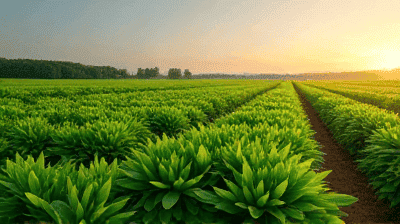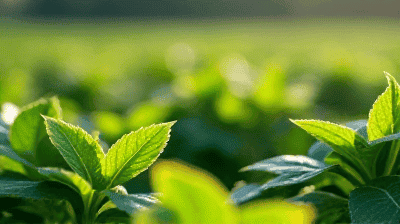
The agriculture industry is undergoing a technological revolution, driven by advancements in artificial intelligence and machine learning. As the global population continues to grow, the demand for food increases, placing immense pressure on farmers to enhance productivity while minimizing environmental impacts. In this context, AI powered farming has emerged as a transformative force that not only predicts crop diseases but also boosts overall agricultural efficiency.
Understanding AI and Machine Learning in Agriculture
Defining Artificial Intelligence
Artificial intelligence refers to the development of computer systems that can perform tasks that typically require human intelligence. This includes understanding natural language, recognizing patterns, and making decisions based on data. In agriculture, AI applications primarily focus on enhancing productivity, optimizing resource use, and ensuring sustainable practices.
The Role of Machine Learning
Machine learning, a subset of AI, involves the use of algorithms and statistical models that enable computers to learn from and make predictions based on data. In farming, machine learning models analyze vast datasets to identify trends, detect anomalies, and generate insights that can inform decision-making processes.
Why AI is Essential for Modern Farming
The integration of AI into farming practices is crucial for several reasons:
Data-Driven Decisions: Farmers can make informed decisions based on real-time data analysis, helping them respond quickly to emerging challenges.
Predictive Analytics: Machine learning models can forecast potential issues, such as pest infestations or disease outbreaks, allowing for proactive management.
Resource Optimization: AI-powered tools enable farmers to optimize resource use, reducing waste and maximizing both productivity and sustainability.
The Impact of Crop Diseases on Agriculture

Understanding Crop Diseases
Crop diseases can have devastating effects on agricultural yield and quality. These diseases are typically caused by pathogens such as fungi, bacteria, viruses, and nematodes. Environmental factors such as soil conditions, weather patterns, and pest infestations also contribute to the prevalence of crop diseases.
Economic Consequences of Crop Diseases
The economic impact of crop diseases is substantial. According to various studies, crop diseases can lead to a significant reduction in yield and quality, resulting in financial losses for farmers and increased prices for consumers. Globally, billions of dollars are lost each year due to crop failures attributed to disease.
Early Detection as a Solution
Detecting crop diseases early is critical for mitigating their impact. Early intervention can prevent the spread of diseases, reduce the need for chemical treatments, and ultimately save farmers significant costs. This is where AI and machine learning technologies become invaluable tools in modern agriculture.
How AI Predicts Crop Diseases
Data Collection and Analysis
The first step in using AI to predict crop diseases involves collecting data. This data can include:
Environmental Data: Temperature, humidity, rainfall, and soil conditions all play a role in crop health and the prevalence of diseases.
Crop Health Data: Observations regarding plant growth, color changes, and signs of disease are critical for creating accurate predictive models.
Historical Data: Historical records of disease outbreaks can inform future predictions by identifying trends and patterns.
Utilization of IoT Devices
Internet of Things (IoT) devices play a pivotal role in data collection. Sensors placed throughout the fields can monitor various environmental conditions and crop health metrics in real time. These devices provide continuous data streams that feed into machine learning models, allowing for timely and accurate predictions.
Machine Learning Models for Disease Detection
Machine learning models analyze the data collected to predict crop diseases. Several approaches are commonly employed:
Supervised Learning
In supervised learning, algorithms are trained using labeled datasets that include both healthy and diseased crops. The model learns to distinguish between the two by identifying patterns in the data. Once trained, the model can predict the likelihood of disease occurrence based on new, unseen data.
Unsupervised Learning
Unsupervised learning allows machine learning models to identify hidden patterns in unlabeled datasets. This is particularly useful in situations where historical data on diseases is limited. The model can cluster similar data points, revealing potential disease outbreaks without prior labeling.
Deep Learning Techniques
Deep learning, a subset of machine learning, employs neural networks to analyze complex datasets. Convolutional neural networks (CNNs), for example, can analyze images of crops to identify visual signs of disease. These models are particularly effective in image recognition tasks and can achieve high accuracy in disease detection.
Integration with Weather Forecasting
Incorporating weather data into machine learning models can enhance disease prediction accuracy. For example, certain diseases thrive in specific environmental conditions. By analyzing weather forecasts alongside historical disease data, AI can provide more precise predictions and recommendations for preventive measures.
Real-World Applications of AI in Agriculture

Case Study 1: Precision Agriculture
Precision agriculture leverages AI technologies to optimize farming practices. Farmers can use machine learning algorithms to analyze data from various sources, including soil sensors, weather stations, and crop health monitoring devices. This holistic approach allows farmers to apply interventions precisely when and where they are needed, minimizing waste and maximizing efficiency.
Example in Action
A prominent example is seen in the use of drone technology. Drones equipped with sensors and cameras can capture high-resolution images of fields. By applying machine learning algorithms to these images, farmers can detect early signs of disease, assess crop health, and deploy targeted treatments accordingly.
Case Study 2: Crop Disease Prediction Platforms
Numerous platforms have emerged that utilize AI to predict crop diseases. These platforms often combine machine learning models with user-friendly applications that allow farmers to input data and receive recommendations in real time.
Successful Implementation
One such platform is Plantix, which uses machine learning to identify crop diseases based on images uploaded by farmers. By analyzing the photographs and cross-referencing them with its extensive database, Plantix provides instant feedback and suggested treatments. This empowers farmers to take timely action and potentially save their crops.
Case Study 3: Automated Pest Management
AI technologies are also being used in pest management, working in tandem with disease prediction models. By combining data on pest populations with crop health indicators, farmers can optimize pest control measures.
Smart Traps and Monitoring
Smart traps equipped with AI-powered cameras can detect pest infestations in real time. By analyzing the images captured, these systems can identify species and assess population density. This data allows farmers to deploy targeted pest control measures rather than blanket treatments, resulting in cost savings and reduced chemical use.
Boosting Productivity Through AI
Optimizing Resource Use
AI powered farming is instrumental in optimizing resource use, including water, fertilizers, and pesticides. Machine learning models analyze various data points to determine the ideal application rates and timings.
Irrigation Management
Irrigation is a significant component of agricultural productivity. AI systems can analyze weather patterns, soil moisture levels, and crop water requirements to schedule irrigation effectively. This not only conserves water but also enhances crop growth by providing the right amount of moisture when it is needed most.
Enhancing Crop Yields
By integrating AI technologies into farming practices, farmers can enhance crop yields. Through real-time monitoring and predictive analytics, they can implement strategies that maximize growth potential.
Precision Fertilization
Machine learning algorithms can analyze soil health data to recommend precise fertilizer applications. This ensures that plants receive the nutrients they require without over-application, thereby reducing environmental impact and improving overall yields.
Adapting to Climate Change
Climate change poses significant challenges to agriculture, with shifting weather patterns affecting crop health and productivity. AI technologies can help farmers adapt by providing insights into the best crops to plant based on changing conditions.
Predictive Crop Modeling
By analyzing historical climate data alongside crop performance metrics, machine learning models can predict which crops are likely to thrive under projected climate scenarios. This enables farmers to make informed decisions about crop selection, supporting resilience in the face of climate change.
Challenges to Implementing AI in Agriculture

Data Privacy and Security
As farmers increasingly adopt AI technologies, concerns about data privacy and security arise. The collection of large datasets necessitates robust measures to protect sensitive information. Ensuring compliance with data protection regulations is essential for maintaining trust between farmers and technology providers.
High Initial Costs
Implementing AI technologies can involve significant upfront investments, particularly for small-scale farmers. Equipment costs, software development, and infrastructure upgrades can be obstacles to adoption. Providing support and incentives for farmers to invest in AI could help overcome this challenge.
Technology Adoption and Training
The successful integration of AI in farming requires a skilled workforce capable of utilizing these technologies effectively. Farmers may need training and support to understand how to implement and interpret data from AI systems. Outreach programs that focus on technology education will be crucial for ensuring widespread adoption.
Integration with Existing Practices
Many farmers rely on traditional methods passed down through generations. Integrating AI technologies with these existing practices can be challenging. Encouraging a gradual transition, rather than demanding wholesale changes, can help facilitate acceptance and implementation.
Future Trends in AI Powered Farming
Continued Advancements in AI Technologies
As technology evolves, we can expect to see continued advancements in AI and machine learning applications in agriculture. This includes improved algorithms, more sophisticated data analysis techniques, and greater integration with IoT devices.
Expansion of Precision Agriculture
The principles of precision agriculture will continue to expand. As more farmers embrace AI technologies, we will likely see the emergence of even more refined practices. This could include hyper-localized farming solutions that use data from specific fields to optimize input use.
Collaborative Farming Platforms
Future developments may include collaborative farming platforms that allow farmers to share data and insights. By pooling resources and information, farmers can enhance their collective knowledge and improve decision-making processes.
Integration with Sustainable Practices
The future of AI powered farming will not only focus on productivity but also on sustainability. AI technologies can support farmers in adopting practices that protect the environment, conserve resources, and promote biodiversity. This holistic approach will be essential for addressing the challenges posed by climate change and resource depletion.
Conclusion
As we navigate the complexities of modern agriculture, AI powered farming emerges as a vital solution to the numerous challenges facing the industry. By harnessing the power of machine learning to predict crop diseases and boost productivity, farmers can cultivate healthier crops, optimize resource use, and enhance overall agricultural efficiency.
Despite the challenges associated with implementing AI technologies, the potential benefits for both farmers and the environment are immense. As technology continues to advance, we can expect to see a greater adoption of AI in agriculture, leading to a more sustainable and productive future for farming.
AI powered farming is not just a trend; it represents a fundamental shift in how agriculture is approached, paving the way for innovations that will feed the growing global population while preserving the planet.
Related
-

-
Artificial intelligence

-

-

-

-

